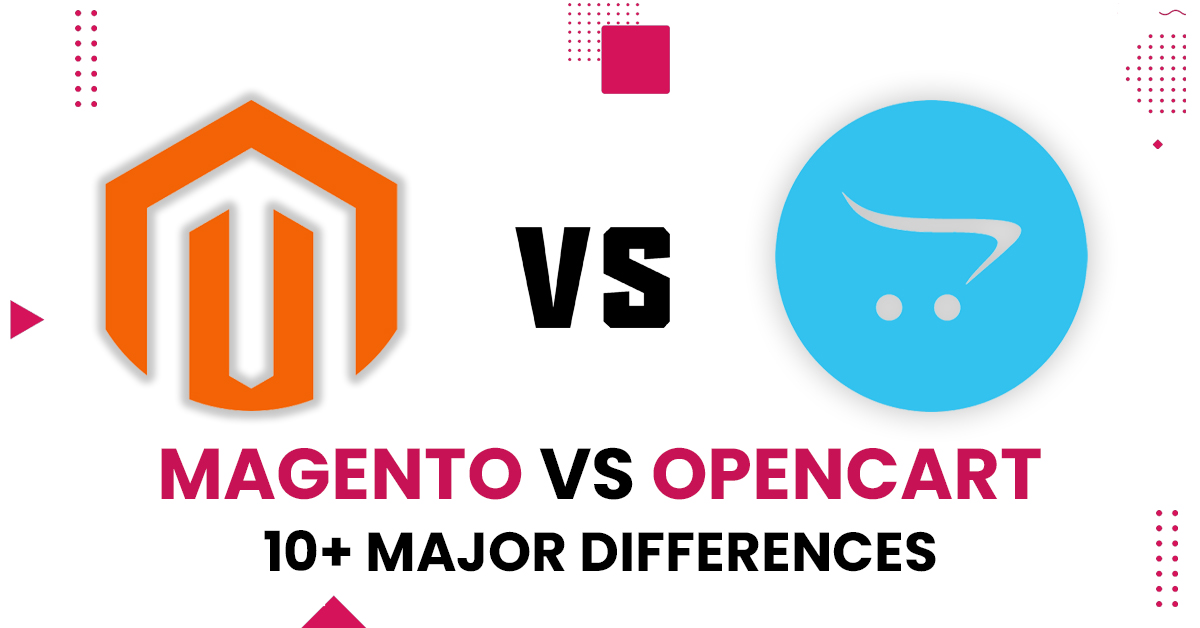
The variety of platforms available in the eCommerce market may need to be clarified for business owners who are just starting their websites. Magento and Opencart – are the two most popular eCommerce platforms in the market. Both are available for free and have robust functionality.
Each platform will provide you with some benefits, but each includes features that may differ. As a business owner, you must choose the platform that will most benefit your business in the long run.
In this article, we will discuss some of Magento vs. OpenCart: Primary similarities and the significant differences between Magento and Opencart.
Before comparing the two platforms, it makes sense to look at some of their similarities first. Here are some of the most important similarities between Magento and OpenCart:
Magento and OpenCart have a robust framework that makes them suitable for large and small businesses.
Both Magento and Opencart supports the use of various type of payment gateways. There is no charge for transactions with such a payment gateway.
Both Magento and Opencart have extensive user interfaces, making configuring every aspect of system settings easier. You may also change the theme by yourself, just like you would do on WordPress or Joomla!
Magento and OpenCart are easy to install, so you can install each one using a simple step-by-step process that requires only a few minutes to complete.
Both Magento and Opencart are easy to extend. You will be provided extensive API documentation with the information you need to build an app on top of each platform.
Now that we have established some of the things both OpenCart and Magento have in common, let’s take a deeper look into Magento vs. Opencart differences:
We specialize in E-commerce App Development and don’t charge for consultation calls. Give us a call now!
Magento’s online page loading time is 665 milliseconds, which is an honorable amount of time. As your business expands, you can meet your needs with the help of Magento’s excellent performance scalability options.
Magento performs smoothly with the number of visitors increasing exponentially; however, the performance varies depending on the size of your website. For developing a Magento website, you may need to hire a Certified Magento developer who can help you optimize your website to improve its performance, or you can go towards a Magento development company.
OpenCart has a performance time of 831 milliseconds, which is significantly slower than Magento. Your website’s loading time depends on your hosting provider, but Opencart provides plenty of performance options to improve page loading.
OpenCart’s architecture provides more flexibility when adding extensions and custom code, enabling you to improve the site’s performance.
02 Cost
Magento Development is focused on the two main elements that require ongoing investment: hosting and premium extensions. The cost of the paid extensions Magento offers in its marketplace ranges from $50 to $500.
However, the cost of the Magento support and maintenance package is a better value, as it offers many features like 24×7 support to fix any Magento issues. You might experience your website and 30 days of extension installation and integration services.
Due to the platform’s lightweight design, OpenCart has lower hosting costs. The price of premium add-ons in the OpenCart marketplace ranges from $10 to $489 per month.
Magento has an easy-to-use interface that lets you quickly set up your website. Although installing Magento is a challenging undertaking, it is a powerful eCommerce platform. If you need programming experience, you must hire a certified Magento developer or company to complete the task.
Magento also has the option of installing modules on the platform, which can be very helpful in making your life simpler. However, Migrating Magento 1 to Magento 2 can also be quite tedious.
A simple platform to install and set up, OpenCart is user-friendly. The use and management of things are even more straightforward for beginners. A fundamental understanding of hosting, FTPs, and security is required.
Magento comes with a bunch of SEO and marketing tools such as Google Analytics, Feedburner, Google Webmaster Tools, OpenSiteExplorer, and Yahoo Site Explorer.
Magento’s marketplace has several premium extensions that can help you create a simple but powerful marketing strategy. These Magento premium extensions are SwipeBox for email marketing, Piwik for tracking site visitors, and many more extensions to boost store sales.
OpenCart offers a few great features that can help you develop your brand. You can easily set up your tagline with the platform, which can act as an identifier for your brand’s social media accounts. OpenCart also allows you to display your location so that local customers can find you.
Opencart also offers a free store locator extension as an extra feature in its marketplace. With this extra, users can also easily add images of their products and descriptions of their brand for more engagement with website visitors.
Magento offers a vast selection of extensions seamlessly integrating with the Magento backend, making it the ideal platform for bigger eCommerce stores.
This platform enables you to expand the features of your online store without having to worry about writing code because there are more than 5000 extensions available.
Around 13,000 extensions with specific functionality and themes are available for OpenCart. You can install any of them, and they will work seamlessly with your OpenCart store. OpenCart enables you to take as many payment channels as you like in a single attachment.
You can find many extensions in the market which help you expand your online business without spending much money. Even the premium extensions have high compatibility rates, so your website works perfectly on different browsers and devices at an affordable price.
With top-notch security features, Magento can strengthen your store. The platform regularly updates its security patches for both old and new versions to enhance security further. Among Magento’s security features are:
Secure Socket Layers (SSL)
AES Encryption
Image Verification for credit card security
Website Firewall
Data Encryption and Decryption Services
OpenCart is carefully designed to protect your data and information. SMTP and FTP-based applications are allowed through OpenCart’s SSL encryption. Plus, you can be assured your data is safe by using the platform’s firewall.
You can also password-protect different areas of your store, like the checkout page, order page, reviews page, and order history. Users will have to enter a password to access these areas of your store.
Customer support is mainly absent from open-source platforms. Magento users cannot contact customer service by live chat, email, or phone. In the Magento Community, there are almost 300,000 people who are active and offer their technical expertise. Even more specific inquiries can be made.
Alternatively, you can consult the Magento blog, which frequently publishes solutions, advice, and other helpful information to enhance the store’s functionality, security, and other elements. Added features, upgrades, and releases for Magento are also available.
For its customers, OpenCart offers two different kinds of support. They have access to a global community forum to exchange information and wisdom. Additionally, for $99 each month, they offer guaranteed support. When a site doesn’t display, it helps users in restoring it.
You can get a highly experienced technical support team who will guide you through the process to get your site running quickly.
Magento has more than thirty payment gateways integrated into its platform, which can provide eCommerce store owners with an exclusive payment gateway.
Users can even integrate these gateways into their website, and they will be able to accept payments in over twenty different currencies. Some Magento Payment Gateways are Stripe, PayPal, Authorize.net, Braintree, and many more.
OpenCart offers several options for credit card payments; however, it has fewer payment gateway options than Magento. Some possible combinations for credit card payments with OpenCart include PayPal, WorldPay, and Sage Pay.
The OpenCart platform supports worldwide credit card payments because it is a cross-platform shopping cart.
To manage your inventory in Magento, you can create a product category or a stock item and set the quantity. To modify the amount, you need to double-click on it and change it according to your requirements.
You can also easily manage your inventory by setting up multiple categories for storing the different types of products in one place. Magento will automatically calculate the total cost of all items within each category and display it on each product page.
OpenCart Inventory Management:
For inventory management, OpenCart provides a seamless overview of all your products in one place. You can easily view the total product cost by categories, search pages by keywords or create new product categories.
You can save your favorite products by getting quick access to them when you are back online. This feature helps increase your store’s sales by keeping the specific products your visitors are interested in.
Magento is a fully mobile-responsive shopping cart platform that can be accessed on almost any device with different screen sizes, including smartphones and tablets. All you need to do is set up a responsive theme in Magento, and you are ready to serve your customers through your mobile website.
The responsive theme automatically adjusts all the design elements according to the screen size. Magento’s sophisticated and clean user interface enhances customers’ experience as they browse your store from their smartphone or tablet.
OpenCart is also a fully mobile-responsive shopping cart platform compatible with most devices. You do not need to set up a responsive theme in OpenCart because it supports mobile and desktop browsers. Since the OpenCart platform works seamlessly with desktop and mobile browsers, customers can access your site from almost any device.
Magento offers its users a host of customization options as they get access to different themes, templates, and extensions.
You can use these customization options to change your eCommerce website in a way you see fit or to make it look more professional than when you first started your online business.
The platform comes with multiple themes and extensions such as SEO, Security, and various currencies that you can use to modify the look and feel of your online store.
OpenCart is also packed with numerous customization options that allow users to change the appearance of their website, add a powerful content management system, integrate payment gateway services, etc.
The OpenCart platform comes with multiple themes and extensions such as SEO, Security, and various languages; however, these features are more limited in Magento alternatives. However, the OpenCart platform provides content management features through its multiple templates and extensions, which could be used to customize your eCommerce website.
As you can see, both Magento and OpenCart are excellent options for eCommerce and online shopping cart platforms. Each of the two platforms has its advantages and disadvantages.
However, the final decision ultimately comes down to the needs of your business. Depending on your requirements, you can consider any of these two platforms without hesitation.

A seasoned technology writer and marketing consultant with over a decade of experience helping businesses grow online. I specialize in content marketing, SEO, web design, and e-commerce development. I am enthusiastic about using cutting-edge technology to acquire high-quality traffic, generate leads, and increase sales for my clients.